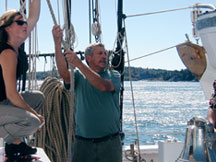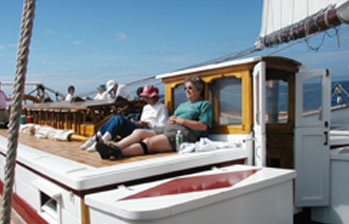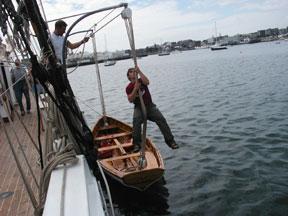Friday
There are 29 stories aboard the schooner Heritage. Here are two of them:
Linda:
Art was acting a little strange before breakfast this morning. When we were seating ourselves in the galley, there were two places together along the wall, and I waved to him to join me. He shook his head and, instead, sat at the other end of the horseshoe table, on the outside. I wondered what was wrong.
Art:
“National Talk Like a Pirate Day” is one of Dave Barry’s, a humor columnist who does guy things and writes about them. This was one of his pet causes, which he might have picked up from one of his alert readers. The year before, I had talked some coworkers at the PUD [Public Utility District] into joining me, and at least wearing costumes, which included eye patches, bandanas, and swords (pronounced “swored’s”). I sang and put on a show for seven or eight people at work. So I was well prepared. I had picked up a T-shirt and sword the day before. And, with the help of Captain Doug, I got a hook. I had been bringing everyone along all week with a few ditties, usually Jim Hawkins and Captain Long John Silver stories, such as, “Hawkins! (blustery voice)” “Aye, captain (squeaky voice)”. “Fetch me my cat o’nines (blustery)” “Aye, aye, captain (squeaky). Here, kitty, kitty.””Argh.” (Linda groans out loud.)
So I went to breakfast, making sure Linda had the camera - which I found out later she didn’t use – and sat so I could slip out the door easily, being as I did not want to miss breakfast.
Linda:
Toward the end of breakfast, I looked up and noticed that Art was no longer in the galley. I was concerned now. I thought he might be sick – maybe he’d eaten too many lobsters, or had gotten a bad one. I decided that if he had not returned in five more minutes, I’d go looking for him.
Art:
Choking down the food, I made my escape. I dressed in my costume, which I had laid out in an empty cabin. To appease the crew, which was on deck eating their breakfast, I sang a little ditty, “Fifteen men on a dead man’s chest, yo ho ho and a bottle of rum (gruff voice).”
Linda:
Suddenly, I heard a commotion on the deck. A man was shouting. The voice sounded like Art’s, in a confrontation of some kind. I hoped he would keep his temper under control and that there wouldn’t be a physical altercation.
A few seconds later Art appeared on the top step of the galley. My mouth dropped open. He was wearing a red bandana, one arm ended not with a hand, but with a hook, and he was waving a pirate’s sword in the other. I remembered then that today was National Talk Like a Pirate Day. Art descended the stairs.

“Avast,” he bellowed. Of course, by now all the other passengers were watching him and, once their initial alarm had passed, they were laughing. Once in the galley, oh, my God, he started to sing a sea chantey, waving his hook in time to the music. I wanted to slide under the table in embarrassment. He sang two verses of the thing, and looked like he was ready to start in on a third. But no, he continued with a ribald joke.
Art:
This started off the descent into the galley, singing “You can tell I am a pirate, for I wear a pirate’s hat. Three times I have been shipwrecked and been found drowned.” A few more verses of this song worked me right into a Hawkins/Silver story. “Hawkins” “Aye, captain” “We’re about to embark on some rape, pillage and plunder. And being as you’re of such an age where you should not participate in such manly escapades…” “Aye, captain” “…I want you only to participate in oral sex. Just talk about it.”
The crew members were hanging over the stairwell. A couple of them almost fell through the hatch on that one. They said Nellie and Gretchen’s mouths almost hit the floor.
Linda:
By this time some of the passengers had turned to look at me. I don’t blush easily, but I’m sure my face was scarlet. God, it was embarrassing. I hoped no one would think he was a complete idiot, and prayed no one would think I had had anything to do with this stunt. I covered my face with both hands and waited for Art’s big moment to pass. Finally, after an endless two minutes or so, Art made his grand exit to laughter and applause – whereupon breakfast ended and the passengers began moving toward the stairs, laughing and shaking their heads.
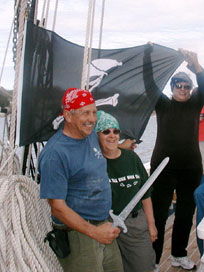
Art:
A couple more songs, and not wanting to start in on any more ribald classics, I made a quick exit.
Linda:
I hoped this display of juvenile behavior was over, but it appeared to have struck a chord with some of the other passengers – particularly the men and including Captain Doug. Within ten minutes four other passengers were wearing bandanas – two of them belonging to Art – and calls of “avast” and “argh” were exchanged all morning. The hook eventually ended up on Captain Doug’s arm. And then the jokes began. “What’s the pirate’s favorite kind of sock? – Argh-yle!” Hoots of laughter. “What’s the pirate’s favorite animal? – Argh-vark!” Chuckles all around. It was remarkable to watch these mature men trying to outdo each other with their “argh” jokes.
Fortunately, by the time we were ready to row ashore to Castine, today’s town, the joke swapping had reached its peak and was winding down. Only three people wore bandanas in the rowboat. I hoped fervently that the rest of the day would be without incident.
It wasn’t, of course. The pirate chatter continued off and on all day, picked up by the other passengers. Art went about his business, grinning to himself from time to time, but letting others carry on his excellent joke.
Art:
The participation lasted all day, with the help of the captain and the other brigands of the schooner Heritage. We even hoisted the Jolly Roger. We noticed another schooner with a similar flag during that day. Most likely they had nothing on us.

[Note: On all six of our Heritage voyages, Art the Pirate has appeared in the galley one morning. Even if it is not on National Talk Like a Pirate Day. It is just as embarrassing to me now as it was back in 2003.]
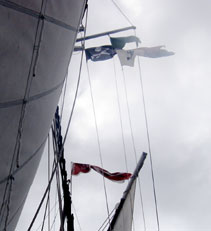
We now return to our regularly scheduled commentary.
We walked through the town of Castine, notable for its Merchant Marine Academy and the uniformed, backpacked young men walking its streets. While some of the passengers toured the ship docked there, Art and I walked across the island to Back Bay Beach and back through town.
When we had reboarded the schooner for our afternoon sail, the news of the hurricane was becoming the front-page story. Isabel was expected to make landfall somewhere in Virginia, and high seas and winds were expected to extend clear to Maine. Off the bow of the schooner, the water was glassy calm. We sat dead in the water for nearly a half hour. Captain Linda said that if the wind didn’t come up in another 15 minutes, she’d use the yawl boat to push us. Captain Doug had decided that we would sail for Rockland Harbor and anchor inside the breakwater as protection from any high seas.
I decided to take my shower while we were still becalmed. When I stepped out ten minutes later, an eight-knot wind had us moving along smartly.
The sail down Penobscot Bay was profoundly restful. At one point I looked up from my book. Sally was working on her needlepoint and four men were asleep in deck chairs. The afternoon snack was chocolate chip cookies warm from the oven. I took two, promising myself to renew my commitment to Weight Watchers for the next several weeks until I recovered from our seagoing feasts.
By the time we reached the Rockland breakwater, the sea was choppier than at any other time during the week. Captain Doug directed the crew to drop two anchors rather than the usual one, and to raise the yawl boat. The sails were lowered and tarps placed over them for protection from possible high winds. We settled in for our final meal and the last Archie stories before we disembarked the next morning.
The captain’s log for Friday, September 19:
Friday, 22 miles. Overcast, calm morning. Motored to Castine for morning shroe trips – got underway at noon and sailed down the bay with an easterly breeze – sometimes very light. It perked up later on and we sailed to anchor behind the Rockland breakwater out of the big swells. It was “Talk Like A Pirate Day!” Aarrgh! Saw a mink whale today and an osprey. Toured the ship at Castine this morning.
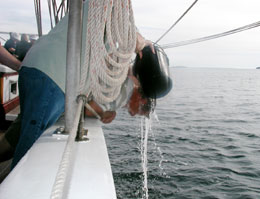
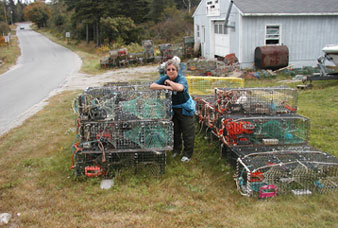
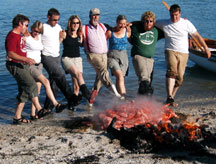
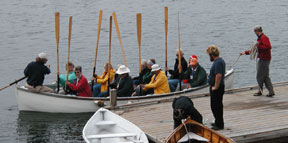

 Noah, the first mate, started the deck engine. The crew kept the lines free and directed the participating passengers. Here’s an example of a direction. Nellie said, “I need two flowers (pronounced “flow-er” with a long “o”). I said, “What is a flower?” She said, “Let this line run through your hands. Don’t try to stop the line. Just keep it flowing smoothly.” I could do that. I was a flower on that occasion.
Noah, the first mate, started the deck engine. The crew kept the lines free and directed the participating passengers. Here’s an example of a direction. Nellie said, “I need two flowers (pronounced “flow-er” with a long “o”). I said, “What is a flower?” She said, “Let this line run through your hands. Don’t try to stop the line. Just keep it flowing smoothly.” I could do that. I was a flower on that occasion.